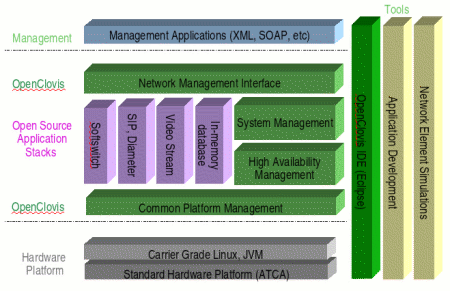Open-source HA middleware spawns apps ecosystem
Oct 13, 2006 — by LinuxDevices Staff — from the LinuxDevices Archive — 2 viewsOpenClovis will launch an open source project site next month, designed to help commercial and open-source software developers add high-availability (HA) features to their applications. The “ClovisForge” site will host wrappers that integrate applications with the OpenClovis suite of dual-licensed, high-availability middleware.
OpenClovis VP of marketing Subbu Iyer describes ClovisForge as “the first site dedicated to open telecom applications.” He says the site grew out of the “converging infrastructure” between IT datacenters and telecommunications, as a result of AdvancedTCA, Carrier Grade Linux, and other standards aimed at leveraging commodity PC components and operating systems in telecom.
Iyer explains, “The two infrastructures are converging. Vendors used to selling into traditional enterprises are being asked to make applications more reliable, as they begin selling to telco's. But, they don't have the skillsets or time to add HA features from scratch.”
“If you are wondering how you can add carrier-grade availability, this is an easy, quick route,” adds Iyer.
The wrappers hosted by ClovisForge are called “execution objects,” or EOs. Iyer says, “We talk in terms of 'EO-nizing' applications. The EO is a wrapper entity that helps monitor and restart an application, or fail it over to a different system in case of hardware failure, or any other errors or alarms.”
ClovisForge aims to integrate open-source application stacks (shown in purple) with OpenClovis HA middleware
The open-source Asterisk IP-PBX software tops the list of open-source applications that will likely gain EOs through ClovisForge, according to Iyer. “Asterisk has created a lot of visibility as a viable IP-PBX, but it lacks HA features that we can provide easily,” he says.
Additional project possibilities include:
- Making existing popular open-source IP applications carrier grade; examples include Asterisk, Yate, OpenH323, and FreeSwitch.
- Making existing popular open-source enterprise applications carrier grade. Examples include Apache, MySQL, and PostgreSQL.
- Embedded database integration, with BerkeleyDB, Solid, TimesTen, and others.
- Making a carrier grade Java execution environment.
- Providing Carrier-Grade Management applications, including integration with OpenNMS, SOAP/XML interface, and so on.
Iyer notes, “Our intention is not to fork out existing packaged solutions. Rather, we want to grow an ecosystem around application integration and development.”
The ClovisForge site infrastructure will be rolled out in November, following the selection of initial projects. The first ClovisForge projects are expected to launch in January, Iyer said.
More about OpenClovis
OpenClovis's OpenClovis suite is described as a hardware- and OS-agnostic “application service platform” (ASP) designed for pre-integration on COTS (commercial off-the-shelf) hardware, such as AdvancedTCA servers and BladeCenters. The suite was released under the GPL in May, for non-commercial use.
Since then, Iyer says, the OpenClovis site has attracted 400 registered users and served about 2,300 source code downloads. He adds, “We've had a lot of activity on the site, and we've had customers that have engaged with us on a commercial basis as a result.”
OpenClovis was founded in 2002 as Clovis Solutions. It employees about 100, worldwide, and is funded by investors that include Sevin Rosen, Walden International, American River Ventures, Intel, and AT&T. It also has partnerships with HP and IBM.
This article was originally published on LinuxDevices.com and has been donated to the open source community by QuinStreet Inc. Please visit LinuxToday.com for up-to-date news and articles about Linux and open source.
